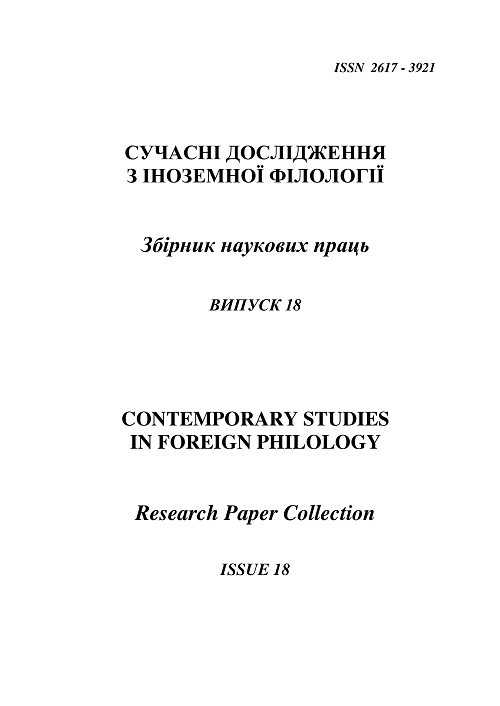Gender in British media: homosexuality and masculinity in selected TV series
DOI:
https://doi.org/10.24144/2617-3921.2020.18.186-197Анотація
The interaction between masculinity and homosexuality is of interest when considering Connell’s structure of gender power relations. Here gay men are considered subordinate to heterosexual ones, thus linking them to femininity. To fight the attributions of femininity, gay men have adopted a wide range of strategies all centred around hyper-masculinity and adherence to upper social classes, which carry the promise of power. The role of media is pivotal in shaping this imagery. It is our aim to analyse two British TV series portraying gay characters in order to uncover the identities, which may shape the perception of viewers. Furthermore, the two series are compared in regard to three aspects: hedonism, effeminacy and promiscuity. The methodology draws from Lacan’s psychoanalytic theory and the feminist film of Laura Mulvey. Due to the constricted nature of TV series, it also includes theory of Marcel Danesi. The outcomes suggest that there is a shift in the portrayal of gay masculinities towards greater conservativism. The comparison also uncovered that promiscuity is still portrayed as widely accepted in the gay community, whereas positions of effeminacy and hedonism have changed. It must be pointed out that such portrayal may be motivated by the presence of the series within heteronormative mainstream media.
Keywords: homosexuality, media, television, masculinity, hegemony, men.
Посилання
Barrett R. From Drag Queens To Leather men. New York: Oxford University Press, 2017. 272p.
Bateman J. A. and Schmidt K.-H. Multimodal Film Analysis. New York: Routledge, 2012. 339p.
Braudy L. and Cohen M. Film Theory and Criticism. Oxford: Oxford University Press, 2009. 926p.
Chandler D. Semiotics: the basics. New York: Routledge, 2007. 326p.
Connell R. W. Masculinities. Los Angeles: University of California Press, 2005. 361p.
Cucumber [TV series]. Directed by David Evans, Alice Troughton and Euros Lyn. UK: Red Production Company, 2015.
Danesi M. Understanding Media Semiotics. London: Arnold, 2002. 264p.
Kirby A. Digimodernism. New York: The Continuum International Publishing Group, Inc., 2009. 288p.
Lawson M. Cucumber-Banana-Tofu Trilogy-first-look review [Online]. Available at: https://www.theguardian.com/tv-and-radio/2015/jan/16/ cucumber-bananatofu-russell-t-davies-review"2015.01.16.
McDonald K. Film Theory. New York: Routledge, 2016. 207p.
McGowan T. The Real Gaze: film theory after Lacan. New York: State University of New York Press, 2007. 268p
Miller T.and Stam R. A Companion to Film Theory. Oxford: Blackwell, 2004. 436p.
Pullen Ch. Straight Girls and Queer Guys. Edinburgh: Edinburgh University Press, 2016. 200p.
Queer as Folk [TV series]. Directed by McDougall Ch., Harding S. and Hunnam Ch. UK: Red Production Company, 1999.
Rushton R.and Bettinson G. What is Film Theory? New York: Open University Press, 2010. 219p.
Sanchez F. J. and Eric Vilain E. Straight-Acting Gays: The Relationship Between Masculine Consciousness, Anti-Effeminacy, and Negative Gay Identity. Archives of Sexual Behaviour. 2012. Vol. 41, No. 1. P. 111-119.
Siebler K. Learning Queer Identity in the Digital Age. New York: Palgrave Macmillan, 2016. 207p.
Zeglin R. J. Assessing the Role of Masculinity in the Transmission of HIV: A Systematic Review to Inform HIV Risk Reduction Counselling Interventions for Men Who Have Sex with Men. Archives of Sexual Behaviour. 2015.Vol. 44, No. 1, p. 1979-1990.
##submission.downloads##
Номер
Розділ
Ліцензія
Автори, які публікуються у цьому журналі, погоджуються з наступними умовами:
- Автори залишають за собою право на авторство своєї роботи та передають журналу право першої публікації цієї роботи на умовах ліцензії Creative Commons Attribution License, котра дозволяє іншим особам вільно розповсюджувати опубліковану роботу з обов'язковим посиланням на авторів оригінальної роботи та першу публікацію роботи у цьому журналі.
- Автори мають право укладати самостійні додаткові угоди щодо неексклюзивного розповсюдження роботи у тому вигляді, в якому вона була опублікована цим журналом (наприклад, розміщувати роботу в електронному сховищі установи або публікувати у складі монографії), за умови збереження посилання на першу публікацію роботи у цьому журналі.
- Політика журналу дозволяє і заохочує розміщення авторами в мережі Інтернет (наприклад, у сховищах установ або на особистих веб-сайтах) рукопису роботи, як до подання цього рукопису до редакції, так і під час його редакційного опрацювання, оскільки це сприяє виникненню продуктивної наукової дискусії та позитивно позначається на оперативності та динаміці цитування опублікованої роботи (див. The Effect of Open Access).

